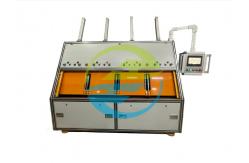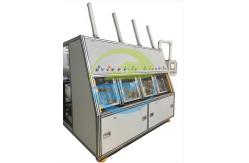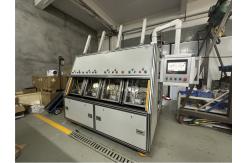Automobile Air Conditioning Compressor Four Chambers Hydrogen And Nitrogen Leak Detection System
|
|
Automobile Air Conditioning Compressor Four Chambers Hydrogen and Nitrogen Leak Detection System
A four-tank hydrogen nitrogen leak detection system is a device used to detect gas leaks in automotive parts or other equipment. It usually consists of four sealed test boxes and corresponding detection devices. When in use, put the parts to be tested into the test box, and then detect whether there is a gas leak by injecting hydrogen and nitrogen gas mixture.
This leak detection system uses a mixture of hydrogen and nitrogen gas as the detection medium because hydrogen is extremely permeable, making it easier to detect small leaks. The gas in the test chamber will interact with the leak point on the surface of the component to be tested, and if there is a leak, the gas will be detected by the detection device.
According to the basic leak detection principle of hydrogen and nitrogen, hydrogen and nitrogen are used as tracer gas to fill the workpiece in a vacuum chamber. Then, the hydrogen and nitrogen leak detector can quickly and accurately determine the leakage situation of the workpiece with high accuracy.
Working process
1. Workpiece installation and vacuum box closing: a. The operator places the workpiece into the vacuum chamber, connects the workpiece interface with the quick connector inside the vacuum chamber, and presses the start button. b. Automatically close the vacuum chamber, and the detection cycle begins immediately. Note: Grating protectors are installed on both sides of the vacuum chamber. When closing the vacuum chamber door, ensure that there are no objects interfering with the movement of the vacuum chamber in the closing area. 2. Vacuum chamber vacuuming and workpiece vacuuming: a. Automatically vacuum the vacuum chamber until the vacuum level inside reaches the set opening pressure. b. At the same time, automatically vacuum the workpiece until the vacuum level inside the workpiece reaches the set vacuum value. 3. Workpiece hydrogen nitrogen filling, medium leakage, and fine leakage detection a. Automatically fill the workpiece with hydrogen and nitrogen gas at the set pressure until the pressure inside the workpiece reaches the set value. b. Medium leakage detection: After the completion of hydrogen and nitrogen filling, the workpiece is automatically maintained under pressure, and whether there is medium leakage is determined based on the pressure drop value inside the workpiece: If the pressure drop value inside the workpiece exceeds the set range, the leak detection process will be terminated, and the operation interface will indicate medium leakage and recover the gas. c. After the completion of medium leakage, perform micro leakage judgment: If the leak detector detects a hydrogen and nitrogen signal exceeding the set value in the vacuum chamber, it indicates that there is fine leakage in the workpiece, and a fine leakage indication signal is provided on the operation interface. If the leak detector does not detect hydrogen and nitrogen signals exceeding the set value in the vacuum chamber, it indicates that the workpiece has passed the inspection, and a qualified signal is provided on the operation interface. 4. Vacuum chamber inflation a. Automatically fill the vacuum chamber with atmosphere. b. At the same time, the hydrogen and nitrogen inside the workpiece are automatically recovered. 5. Workpiece unloading a. If the test is qualified: The vacuum chamber door automatically opens. The operator disengages the joint inside the chamber from the workpiece interface. b. If the test fails: Press the confirm button manually and the vacuum chamber door will automatically open. The operator disengages the joint inside the box from the workpiece interface. c. If an alarm occurs during the detection process: Manually press the confirmation button. The vacuum chamber door automatically opens. Press the fault message prompt on the touch screen to clear the alarm status, and then retest the workpiece. Note: For sorting products with leakage detected: 1. Take out one workpiece and leave one workpiece. 2. Continue testing one workpiece left in the chamber according to the normal operating method. This cycle continues until a specific leaking workpiece is detected.
Parameters
|
||||||||||||||||||||
| Product Tags: Hydrogen And Nitrogen Leak Detection System Four Chambers Nitrogen Leak Detection System |
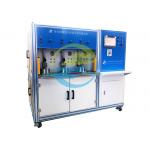
|
Capacity≥ 205pcs/h Relay Ceramic Shell Helium Mass Spectrometry Leak Detection Equipment |
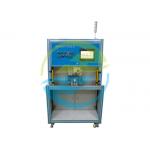
|
Cylindrical Cell Helium Charging And Helium Leak Testing Equipment for Electric Vehicles |
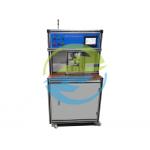
|
Helium Leak Testing Equipment for High Voltage DC Relay for New Energy Vehicles With One Test Chamber |
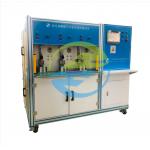
|
Ceramic Housing for Electric Vehicle Relay Helium Leak Testing Equipment |

|
20 Minutes Chamber Helium Leak Testing Equipment 0.1Mpa - 4.5Mpa Gross Leak |
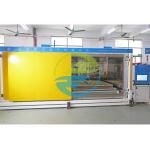
|
Vacuum Chamber Type Helium Leak Detection System 0.1-4.5Mpa Gross Leak Pressure |

